Cambridgeshire
CAMBRIDGE
There has been a University at Cambridge since the foundation of Peterhouse College in 1284. Today the colleges - mostly spread along the banks of the sluggish River Cam - are among the most beautiful buildings in England. Their chapels and halls, courts and towers attract visitors and students from across the world. Tourists are welcome in Cambridge but cars are not - the preferred mode of transport is by foot or bicycle. Those coming by road should make use of the efficient Park and Ride scheme which deposits you in Emmanuel Street (CB2 3AP) near the city centre. Most places of interest are within easy walking distance from here.
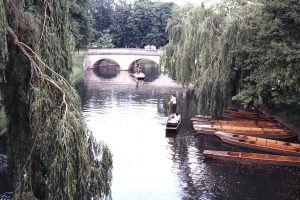
Punts on the River Cam
Most of the colleges are open to visitors, although some now charge for entry. Tourists are politely reminded that the colleges are working institutions and to refrain from noise or other behaviour which interferes with study. There are times when colleges may be closed, especially during University examinations, so it is best to check in advance. This guide is limited to places relevant to Christian heritage. For other tourist information, a comprehensive city guide and map should be obtained.
A good place to start is the Round Church (CB2 1UB) in Bridge Street near the centre. With its distinctive Norman doorway, the building dates from about 1130, making it at least 100 years older than the earliest colleges. It now serves as the base for Cambridge Christian Heritage, which provides a display and audio-visual materials on this theme (see www.christianheritage.org.uk). Guided walks are also organised from here . The notes below are arranged in the order of a possible walk around the city in a rough clockwise direction, starting from the bus stop in Emmanuel Street.
Emmanuel College
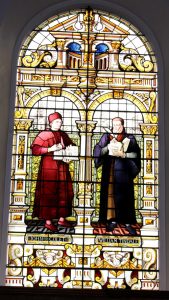
Tyndale window, Emmanuel College
Known to students as "Emma", the college was dismissed by Archbishop Laud in the seventeenth century as that nest of puritans - and not without reason. Its scholars at the time included such men as William Gurnall, Thomas Brooks and Thomas Watson, whose weighty tomes of puritan theology are still published and read today. There are also strong links with the early history of America, as former students included the "New England Three" - John Cotton, Thomas Hooker and Thomas Shepard - who all emigrated to the fledgling colonies in the years following the Pilgrim Fathers. The American link is further reinforced by John Harvard, another former student and founder of Harvard University.
In the chapel, a more ecumenical approach has been adopted. The stained glass portraits filling the windows include St Augustine (of Hippo, not Canterbury), scholar and archbishop Anselm, protestant martyr Thomas Cranmer alongside Catholic martyr John Fisher, Bible translator William Tyndale, humanist scholar John Colet, John Harvard and latter-day puritan William Law, a former student whose Serious Call to a Devout and Holy Life influenced John Wesley and many others.
St Andrew's Street Baptist Church
It was here, though in a former building on the site, that the famous Baptist preacher Charles Haddon Spurgeon (1834-1892) began his ministry. He was a teenage Sunday School teacher, but such was his eloquence that many of the adults in the church deserted the main services and started attending the Sunday School. The young evangelist went on to pastor a small church at Waterbeach near Cambridge, before transferring to London, where, still in his teens, he preached to vast congregations.
The present church was built in 1903, but there appears to be no memorial to Spurgeon. The stained glass windows behind the pulpit show scenes from Pilgrim's Progress, and the church also has a chair that belonged to Baptist pioneer missionary William Carey.
Pembroke College
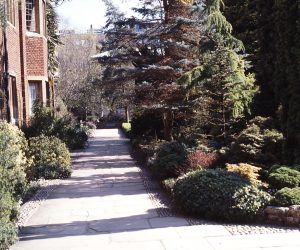
Ridley's Walk
Located on Trumpington Street, the college has strong links to Nicholas Ridley (1503-1555), reformer Bishop of London in the reign of Edward VI and founder of many hospitals and schools, whose portrait hangs in the dining hall. A path through the gardens here is known as Ridley's Walk.
Ridley came here as a student in 1518, was made a Fellow of the college in 1524, Senior Proctor in 1533 and Master from 1540 to 1553. He combined this role with the office of Bishop of Rochester from 1547 and Bishop of London from 1550. The accession of Queen Mary, Edward's Catholic half-sister, brought about Ridley's demise. He was stripped of his offices, and died at the stake with fellow Bishop Hugh Latimer at Oxford in 1555.
Other students at Pembroke included Ridley's fellow Protestants John Bradford (1510-1555) and John Rogers (c1500-1555), who both perished in the fires of Smithfield during Mary's reign. Bradford was ordained by Ridley and became his chaplain; he may be the subject of another sixteenth century portrait in the dining hall.
Queens College
The entrance is in Queens Lane off Silver Street and the college buildings are extensive, covering six separate courts, the oldest dating from 1449. Some parts of the college are reached across the misnamed Mathematical Bridge, which replaces one originally built by James Essex in 1749.
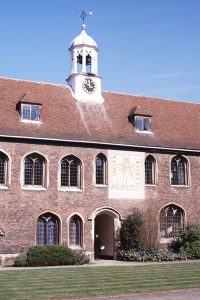
Queen's College
The Dutch scholar Desiderius Erasmus (1466-1536) came to Cambridge as Professor of Greek and helped to establish its reputation as a centre of European learning. His publication of the Greek New Testament based on original documents gave a tremendous impetus to the Reformation. From about 1511 to 1514, he is believed to have lodged at rooms in the south-east corner of the Cloister Court, now known as the Erasmus Tower.
In 1788, Isaac Milner (1750-1820), a man of strong intellect and character, became president of the college. He made Queen's a centre for evangelical education and young men seeking ordination came here from all parts of the country. The college increased in size from one of the smallest to one of the largest. Milner is buried in the chapel, but despite his achievements he is not mentioned in the visitors' guide.
Milner began his working life as a weaver, but came to Queen's as a student in 1770, was elected a Fellow in 1776 and ordained in 1777. By 1792 he was Vice-Chancellor of the University, while also serving as Dean of Carlisle. The terms were devoted to the University, while his vacations were spent in Carlisle, where his sermons attracted such crowds that it was said you could walk upon the heads of the people. Milner is also remembered as the friend and mentor of the young William Wilberforce, and led him to a personal faith in Christ during a winter spent in the south of France in 1784-85. In addition to his academic duties, Milner served as rector of the nearby St Botolph's church from 1778 to 1792.
Great St Mary's
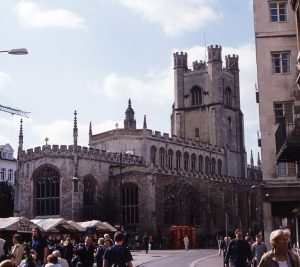
Great St Mary's
The church of St Mary the Great is the University Church, standing immediately opposite King's College. At the time of the Reformation, Great St Mary's was a powerful centre for the new thinking as university men discussed the teachings of Erasmus and Luther. Most of the English Reformers, including Latimer, Ridley and Cranmer, preached here.
The German Reformer Martin Bucer (1491-1551) came to Cambridge as Professor of Divinity at the invitation of Thomas Cranmer. When he died, he was buried in the chancel here, the spot now marked by a brass plate to the right of the altar with an inscription in Latin. However, the ever-vengeful Queen Mary did not let him rest in peace. Not content with burning the living, she had his remains exhumed and burned to ashes in the Market Place in 1557.
St Edward's Church
The church of St Edward King and Martyr backs onto Peas Hill, a stone's throw from Great St Mary's. It is dedicated to a little-known Saxon king, murdered in 979, and not to be confused with St Edmund, also king and martyr slain by the Danes in 870.
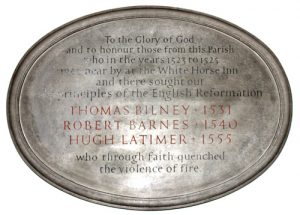
Reformers memorial
The church has been called the "Cradle of the English Reformation", for it was here that Thomas Bilney, Robert Barnes and Hugh Latimer, amongst others, proclaimed the new teaching that was beginning to permeate the English church. The scholars met to discuss the writings of the continental reformers at the White Horse Inn, which formerly stood in King's Parade, between the present buildings of King's College and St Catherine's College.
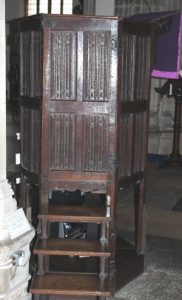
Latimer's pulpit
According to some historians, it was the conversion of Bilney, a meek and humble soul, to the doctrine of justification by faith that began the Reformation in England. He influenced both Barnes, prior of the Augustinian friary in Cambridge, and Latimer towards Protestant views. Bilney was burned at the stake in Norwich in 1531 and Barnes at Smithfield in 1540, both in the reign of Henry VIII and well before the main body of Protestant martyrs in Queen Mary's reign.
The church has an oval plaque commemorating the martyrs and a stained glass window dedicated to Latimer. A sixteenth century pulpit used by Latimer, lost for a time, was rediscovered and returned to the church in 1949.
King's College
Visitors come from across the world to view the glories of the chapel, begun on the orders of the young King Henry VI in 1441. Its special features include the magnificent fan-vaulted ceiling, the immense carved oak screen carrying the initials of Henry VIII and Anne Boleyn, and Rubens' Adoration of the Magi above the altar.
Not many will notice a stone in the floor near the North Porch entrance, carrying the initials C. S. and the date 1836. It marks the last resting place of Charles Simeon, a graduate and Fellow of the college, and vicar of Holy Trinity Church for 54 years.
Seen from the river, the eighteenth century facade of King's College provides the centrepiece of one of the most famous Cambridge views, known as the The Backs. Simeon's rooms were behind the semicircular window above the central doorway.
Clare College
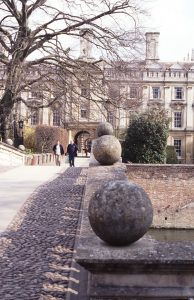
Clare College
The entrance is in Trinity Lane, close to the North Porch of Kings College Chapel. Clare is the second oldest college in the University and its grounds include a beautiful bridge across the Cam from which you can watch the antics of inexperienced punters. Former students include bishop and reformer Hugh Latimer (1485-1555) whose portrait hangs in the seventeenth century hall.
Latimer supported Catholic doctrines until the age of thirty when he came under the influence Protestant reformers. Appointed Bishop of Worcester in 1535, he was renowned for his plain and outspoken sermons, sometimes even rebuking Henry VIII from the pulpit. He was arrested in Queen Mary's reign and died at the stake alongside fellow bishop Nicholas Ridley at Oxford in 1555.
St John's College

Wilberforce statue
The college's most famous alumnus was William Wilberforce (1759-1833), who is commemorated by a life-size statue in the chapel and a portrait in the hall. The statue shows Wilberforce seated, and cleverly captures his physique and character in later life. Always slightly built, his body became twisted by a spinal deformity, but his face shows a peace and calm borne of profound faith. The portrait by George Richmond shows the great philanthropist with his head tilted and a benign expression.
Wilberforce's achievements in opposing the slave trade and a host of other good causes are recorded elsewhere. Curiously, another student of St John's, contemporary with Wilberforce, was Thomas Clarkson (1760-1846), who contributed as much, or even more, to the campaign for abolition. It seems that as students neither man had yet taken up the cause that would later dominate their lives. Clarkson is commemorated by a statue on the outside wall of the chapel. It can be seen just to the left of the gates at the back entrance of the college in St John's Street.
Jesus College
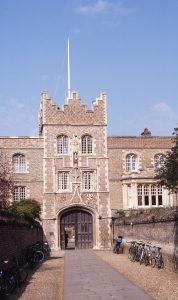
Jesus Colllege
Set back from the road in Jesus Lane, the college stands in beautiful grounds backing onto the river. In the early sixteenth century, the young Thomas Cranmer (1489-1556) arrived as a student. He was ordained priest in 1523 and by 1529 was advising Henry VIII on the legality of his marriage to Catherine of Aragon. In 1532 he was appointed Archbishop of Canterbury and stood godfather to both the future Queen Elizabeth and her half-brother, the boy-king Edward VI. Cranmer became chief adviser to Edward in 1547 and during the reign he produced his most enduring monument - the incomparable Book of Common Prayer.

Cranmer memorial
With such a wilful and domineering sovereign, Cranmer's life inevitably involved compromise, and he has attracted criticism for compliance in Henry's marital and judicial excesses. His end, however, was a noble one. In 1553, on the accession of Queen Mary, daughter of Catherine of Aragon, he was arrested and charged with treason for supporting the unfortunate Lady Jane Grey. Mary was determined to wreak vengeance on the former Archbishop, both for his Protestant opinions and his part in her mother's divorce. In fear, Cranmer signed six documents of recantation, but when this failed to assuage the Queen's wrath he was sent for trial in St Mary's Church in Oxford. On conviction he was dragged to the stake in Broad Street in 1556, and as the fire was lit, thrust his right hand into the flames first, for the offence of having signed the documents.
One of the rooms at Jesus is named after Cranmer and his portrait hangs in the hall, along with that of his master Henry VIII. On the south transept wall in the chapel is a plain marble slab with a relief portrait and the one word Cranmer - no dates, no epitaph.
Sidney Sussex College
Standing on the corner of Sidney Street and Jesus Lane, the college was attended by Oliver Cromwell from 1616 to 1617 and has various memories of the Lord Protector, including one rather macabre. In the dining hall is the famous portrait for which Cromwell said he wished to be painted warts and all. It has been attributed to Sir Peter Lely, but is more likely to be the work of Samuel Cooper. The portrait carries no signature, but tucked into the corner is Cromwell's own signature on a piece of paper.
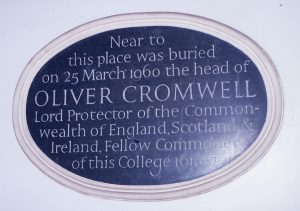
Cromwell plaque
When Cromwell died in 1658, he was buried in Westminster Abbey, but at the Restoration in 1660, Charles II wrought vengeance on the remains of the man he blamed for the execution of his father. Cromwell's body was exhumed and hanged at Tyburn and his head displayed above Westminster Hall where it remained for many years. One night it fell down in a storm and, after various adventures, his skull found a permanent resting place in the chapel of his former college in 1960. An oval plaque in the entrance lobby of the chapel commemorates the occasion.
Holy Trinity Church
Standing on the corner of Market Street and Sidney Street, Holy Trinity is remembered for the long ministry of Charles Simeon (1759-1836), who came here as vicar in 1782 and remained until his death fifty-four years later. As an undergraduate at King's College, Simeon was known chiefly for his love of horses and extravagance in dress. Learning that he was compelled to attend communion by the rules of his college, he bought a book by Bishop Wilson on the Lord's Supper, learned for the first time of the atoning work of Jesus and was converted.
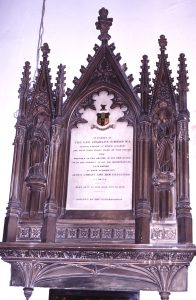
Charles Simeon memorial
In the early years of his ministry, Simeon faced fierce opposition for his evangelical views. Seatholders locked their pews forcing the congregations to stand, and the streets around the church were the scene of riots and disorder. Slowly attitudes changed, and services attracted large numbers of students. Simeon moulded the lives of the men from whom the next generation of evangelical clergy were drawn. He was closely involved in the growing missionary movement and had a particular interest in India. Missionary activity was discouraged by the Indian authorities, but Simeon was able to secure the appointment of able men as chaplains to the East India Company, the most famous of whom was Henry Martyn (1781-1812), whose portrait hangs in the church vestry.
There is an elaborate neo-gothic memorial to Simeon on the south side of the chancel, and close by are others to several of his missionary disciples. In addition to Martyn, Claudius Buchanan, Daniel Corrie, David Brown and Thomas Thomason, who all served in India, are remembered here. The stained glass windows above illustrate scenes from their lives in the orient.
On the west side of the church is the Henry Martyn Memorial Hall, opened in 1887 as a focus for the missionary interest of the church. Martyn, a mathematics scholar, served as Simeon's curate from 1803 to 1805. He arrived in India in 1806 and translated the New Testament into Urdu. Plagued by ill-health, he planned to return home via Persia. While there, he completed a Persian translation of the New Testament, presenting a beautifully bound copy to the Shah and courageously debating matters of doctrine with Muslim scholars. Continuing his homeward journey by land, he died of consumption at Tokat in Turkish Armenia at the age of thirty-one.
In the century before Simeon's arrival, two distinguished puritans preached at Holy Trinity. Richard Sibbes (1577-1635) was lecturer from 1610 to 1620, attracting large numbers of students away from Great St Mary's, the University Church. He returned in 1633 as vicar until his death two years later. In 1628, Thomas Goodwin (1600-1680) became lecturer and later vicar. He separated from the Church of England in 1633 and later became chaplain to Oliver Cromwell and President of Magdalen College, Oxford.
Christ's College
The college stands on the corner of Hobson Street. Its most famous student was John Milton (1608-1674), poet, advocate of press freedom and apologist for Cromwell's regime. Milton's boyish looks earned him the nickname The Lady of Christ's. His portrait hangs in the dining hall. The manuscript of Milton's Paradise Lost is in the Fitzwilliam Museum.
ISLEHAM
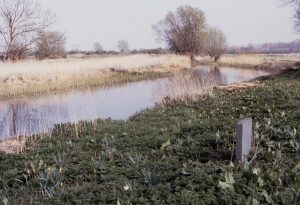
Site of Spurgeon's baptism
It was to this village, just west of Mildenhall, that the young Charles Spurgeon (1834-1892) came for baptism in the River Lark on a cold spring day in 1850. There is a memorial stone at the spot, which can be reached from East Fen Lane, but this lies across private farmland and permission must first be sought from Appleyard Farm in Houghtons Lane. An alternative is to park close to Isleham marina, cross the river at the lock and walk along the footpath on the east bank of the river. The site, a busy ferry crossing in Spurgeon's time, can be viewed from the opposite bank.
In later years, Spurgeon would return to the village to preach. On these occasions tea would be served in a barn in West Street (CB7 5SB). This is now a private house but retains the name Spurgeon's Barn. It stands back from the road just opposite the entrance to Priory Gardens.
TEVERSHAM
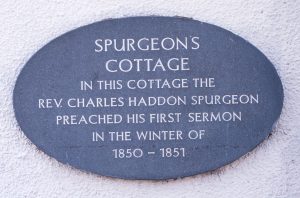
Spurgeon's Cottage
The village lies about three miles east of Cambridge, not far from the airport. A pebble-dashed house at 6 High Street (CB1 9AS) seems unremarkable, but an oval plaque on the side reveals its place in our story In this cottage the Rev Charles Haddon Spurgeon preached his first sermon in the winter of 1850-51.
Spurgeon had been sent there with another very diffident student from a Baptist Church in Cambridge, each believing that the other would be the preacher. The congregation consisted of a small group of farm labourers and their families. Despite his lack of preparation, the sixteen-year-old Spurgeon conducted the service with confidence, including an impromptu sermon.
WATERBEACH
Chapel Street forms one side of the village green and the Baptist Chapel (CB25 9HR) is where Spurgeon began his first pastorate (at the tender age of seventeen) in 1851. He started with a congregation of about forty, but within two years it had grown to four hundred. Still a teenager, he moved on to London, preaching to even greater numbers.
The chapel Spurgeon had known was replaced by the present building in 1863 and he returned to lay the foundation stone. It is in the simple non-conformist style, with yellow brickwork typical of this area. The window frames are highlighted by red brick surrounds and the porch has fluted cast iron pillars.
HUNTINGDON
The long main street of Huntingdon has witnessed more than its fair share of history. Oliver Cromwell was born at one end and William Cowper lived at the other. In the middle, both Cromwell and Samuel Pepys went to school in an ancient building - all that remains of a monastic hospital founded in 1160. We even drive into the town over a bridge across the River Ouse built in 1332.
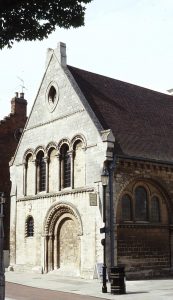
Cromwell Museum, Huntingdon
At the top end of the High Street, furthest from the bridge, we can see the white painted Cromwell House, now a nursing home. This stands on the site of an earlier building where young Oliver first saw the light of day in 1599. His family had acquired the property, once an Augustinian Friary, at the Dissolution of the Monasteries, organised by their distant relative Thomas Cromwell. The present building dates from about 1830, but an inscription and coat of arms remind us of its place in history.
Cromwell was baptized in St John's church which was demolished in the Civil War. Its font may be the one now in All Saints Church on the north side of Market Hill. Opposite All Saints is the Cromwell Museum (PE29 3LF), located in the ancient schoolroom which Cromwell attended in about 1610. It was once the infirmary hall of the Hospital of St John the Baptist. The arches over the bricked up doorway at the front and the windows above reveal its Norman origins. The grammar school was established here in 1565 and the premises were still in educational use until the 1930s. Despite limited space it is well stocked with Cromwelliana. There are portraits of the Cromwell family, together with books, letters, armour, miniatures and paintings of Civil War battle scenes. One of the finest treasures is a beautiful Florentine cabinet with stone inlay presented to Cromwell by the Grand Duke of Tuscany.
Oliver Cromwell (1599-1658) is one of the most complex and controversial characters in English history and some may question his inclusion in this guide. His reputation has ebbed and flowed with the tides of fashion and the prejudices of historians. While revered by his followers, the restored monarchy of Charles II desecrated his body and did everything to blacken his name. With no background or training as a soldier, he took up arms against the King and proved himself a military genius. He fought a Civil War to defend the rights of Parliament, but eventually expelled it and ruled as virtual dictator. Vague and indecisive at times, he could act with frightening speed when his mind was made up. Initially he did not oppose the concept of monarchy and sought compromise with Charles I, but in the end he forced through the King's execution and presided over Britain's only experiment with republicanism. Cromwell personally favoured religious liberty and enjoyed music and the arts, but some of his supporters preferred more narrow and extreme forms of puritanism. His army was devout and highly disciplined, but his reputation was marred by atrocities in Ireland. The jury is still out on Oliver Cromwell; it will remain so for some time.
On some matters historians are agreed. Cromwell had undergone an intense conversion experience and was personally devout. He was a loving family man, devoted to his wife and children. He firmly believed in divine providence and that his victories on the battlefield, as in Old Testament times, were a sign of God's favour.
Towards the southern end of the High Street, opposite St Mary's Church, is a red brick Georgian house now used as offices. A small round plaque records that this was the home of William Cowper from 1765 to 1767. He was the guest of Mary Unwin and her clergyman husband, whom the poet described as the most agreeable family in the world. After her husband's death, Mrs Unwin spent the rest of her life caring for Cowper who was subject to bouts of severe depression. This included a long period at Olney in Buckinghamshire, where, in collaboration with John Newton, he produced his most famous hymns.
ST IVES
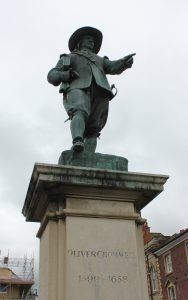
Cromwell statue
The family of Oliver Cromwell owned land in these parts and before the outbreak of the Civil War Cromwell was a local farmer, while also serving as MP for Huntingdon from 1628. In about 1900, admirers of Cromwell felt that he deserved a statue and offered one to his home town of Huntingdon. No doubt basking in the glow of good Queen Victoria's reign, the burghers of Huntingdon felt that they did not wish to be associated with a regicide and declined. It came instead to St Ives and stands in Market Hill in the centre of the town, where the locals seem happy enough to have the Lord Protector described as A Townsman of St Ives on one side of the plinth. He strikes a fairly peaceable pose, with a large Bible tucked under his arm and his sword sheathed and hanging at his side (PE27 5AD).
ELY
The magnificent Cathedral with its bold west tower and majestic central lantern rises like a mirage on the horizon as you approach the town across the flat surrounding fenland. In fact, it is the landscape that has shrunk, and has been doing so since drainage schemes were first begun by Dutch engineers nearly four hundred years ago. For centuries Ely was virtually an island and the inhabitants lived in their own waterworld of the Fens, catching eels and trapping wildfowl, despised or ignored by the rest of their countrymen. Even in the twentieth century the waters occasionally broke through and flooded the surrounding land.
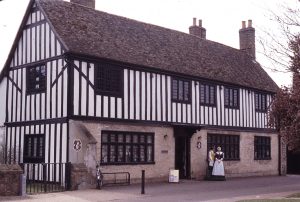
Cromwell House Museum, Ely
The cathedral stands in its own grassy precincts surrounded by ancient and beautiful buildings. However, it is another building that brings us here. Oliver Cromwell's house in St Mary's Street adjoins the churchyard of St Mary's, a short walk from the west door of the cathedral (CB7 4HF). Cromwell lived here from 1636 to 1647, and his two youngest daughters were born here. The period covered the recall of Parliament by Charles I in 1640 after a lapse of eleven years, and the early battles of the Civil War. Cromwell served as MP for Ely in the parliament of 1628-29, but returned to manage his estates in the area during the long period of parliamentary suspension.
The half-timbered house has been a pub, the vicarage of St Mary's, and is now the Museum and Tourist Information Centre, but has changed relatively little since Cromwell's day. Some of the rooms have dark panelling and subdued lighting, with moving effigies of Cromwell and his family. Recorded commentaries are activated by the entry of visitors. Upstairs there is an original full length portrait, and one room has a summary of the main events of the Civil War and a display of replica arms and armour from the period. A back room which probably served as Cromwell's bedroom has an effigy of the Lord Protector on his four-poster deathbed, although he actually died at Whitehall in London.
WISBECH
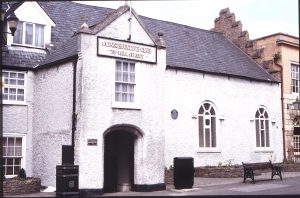
Thomas Clarkson's birthplace
The anti-slavery campaigner Thomas Clarkson (1760-1845) was born in the former Grammar School at 29 Hill Street (PE13 1AQ), where his father was headmaster. This building, with its slate roof and pebble-dashed frontage, served the needs of the school from 1549 to 1898. He later lived at 8 York Row, now part of a row of shops. Both buildings carry the familiar blue plaques.
Clarkson went to St John's College, Cambridge and was awarded a prize for a Latin essay on slavery. A pause for reflection on a journey to London convinced him that academic dabbling was not enough. He devoted the rest of his long life to arousing the conscience of the nation against the abominations of the trade. His meticulous researches provided essential evidence for Wilberforce and others, who were taking up the fight in Parliament. Working under cover in Bristol and Liverpool, Clarkson was often in danger of his life from hostile sea captains. He once searched fifty-seven ships to find a single sailor whose evidence he considered important.
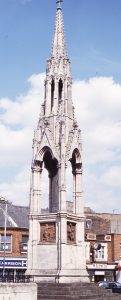
Clarkson monument
The excellent Wisbech and Fenland Museum is in Museum Square (PE13 1ES), adjacent to the Georgian Crescent. It has a special display relating to the work of Clarkson and his family. His brother John was also active in the movement and was involved in the foundation of Sierra Leone as a refuge for liberated slaves. Among the items is what Clarkson called his West African collection. It is a case containing various products from that region which he suggested could be traded legitimately to replace the human cargoes.
In front of the Town Bridge is the Clarkson Memorial, erected in 1880. Beneath a neo-gothic canopy, the statue shows Clarkson holding some shackles. At the base are panels showing two of Clarkson's closest collaborators, William Wilberforce and Granville Sharp. The rear panel, somewhat eroded, depicts a liberated African slave.
GAMLINGAY
Memories of John Bunyan spill over the border from Bedfordshire and the Baptist Church in Stocks Lane (SG19 3JR) traces its origins to his ministry. He used to preach in a barn in Mill Street, which was destroyed by a fire in 1897. This was behind the Anglican church but the whole street now seems to have disappeared beneath new housing. The oldest part of the present Baptist church was built in 1710 with a new section added in 1848. The church has records in Bunyan's handwriting, including the admission of Agnes Beaumont as a member in 1672. She was a farmer's daughter from Edworth in Bedfordshire and we tell her story there.


